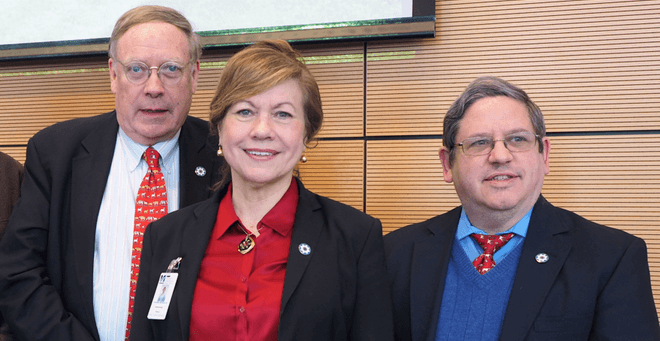American Macular Degeneration Foundation donates $100K for Dr. Seddon’s research
March 2020

and Paul Gariepy
Macular degeneration is degrading Chip Goehring’s eyesight, but it has not diminished his vision for supporting research that may one day help to cure the most common cause of blindness in people over the age of 60.
Mr. Goehring is the founder and president of the Northampton-based American Macular Degeneration Foundation (AMDF), a leading source of information for patients and funding for researchers. He was only 39 years old when diagnosed with macular degeneration. At the time, the prospect of losing his sight within 20 years was a major blow and the lack of information available on the disease became a call to action.
“It was 1993, and I had never heard of the disease. Not many people had,” Goehring said. “At that time, I was an unhappy lawyer, so I decided to do something that could actually help people and make an impact on this disease.”
With the help of several friends, including attorney Paul F. Gariepy of Cummington, who is the secretary of the foundation, Goehring established AMDF in 1996. Since then, the foundation has raised millions of dollars and funded research teams at several institutions working to develop a better understanding of the disease and targets for new therapies.
Age-related macular degeneration (AMD) affects approximately 11 million people in the United States. As the baby boom generation ages, AMD’s toll is expected to grow significantly. The disease damages layers of tissue at the back of the eye known as the macula. Over time, patients get cloudy spots, which can become larger and darker, blacking out their central field of vision. Eventually, many with AMD become legally blind. There is currently no cure.
After his diagnosis, Goehring threw himself into research, trying to learn everything he could about the disease. That effort quickly led him to Johanna Seddon, MD, ScM, who at the time was Director of the Epidemiology and Clinical Research Unit at Massachusetts Eye and Ear Infirmary.
“She was the first researcher focused on this disease that I could find,” Goehring said. “Not only is she a pioneer in various aspects of macular diseases, she is one of the best physicians a patient could have. She’s my doctor, and I could not hope for a more caring person.”
Over the course of more than 30 years, Dr. Seddon has emerged as a global leader in the field. She conducted the foundational epidemiological studies of AMD, including the first large-scale study of identical and fraternal twins in families with a history of AMD. Dr. Seddon’s lab has discovered many of the genes associated with AMD. She has also discovered numerous modifiable factors, like diet, exercise and smoking cessation, that can help prevent or delay onset of the disease. Her team conducted the first study that documented the ocular health benefits of lutein and zeaxanthin, which are pigment molecules in many fruits and green leafy vegetables. That dietary advice is now part of global-standard recommendations to manage AMD.
Dr. Seddon joined the faculty at UMass Medical School in 2018 as a professor of ophthalmology & visual sciences and the director of the Retina and Macular Degeneration Center of Excellence. In 2019, she received the Future Vision Award and was inducted into the prestigious American Ophthalmological Society (AOS) for her distinguished contributions to the fields of ophthalmology, retina and macular degeneration.
The AMDF has supported Dr. Seddon’s work for many years and remains a key funder of the work in her lab at UMMS, making a $100,000 contribution in 2019.
“The role of philanthropy is essential in our work, and we are so grateful to have the ongoing support from the foundation,” Dr. Seddon said. “We have NIH funding and that’s important, but it can only take you so far. We would not have made the discoveries we have made without philanthropy.”
Dr. Seddon’s research lab has an extensive biorepository with more than 30 years of AMD patient data, including serum and tissue samples from patients with all forms of the disease. With the advance of genomic and proteomic technologies, her lab and its collaborators are mining all that data for a more detailed understanding of the disease processes. Many of the potential new therapies now in development for AMD are based on the science gleaned from Dr. Seddon’s work.
“When I was first diagnosed, I felt very lost,” Goehring said. “These days, I am much more hopeful, and that hope is in large part due to the work of Dr. Seddon and her team.”
